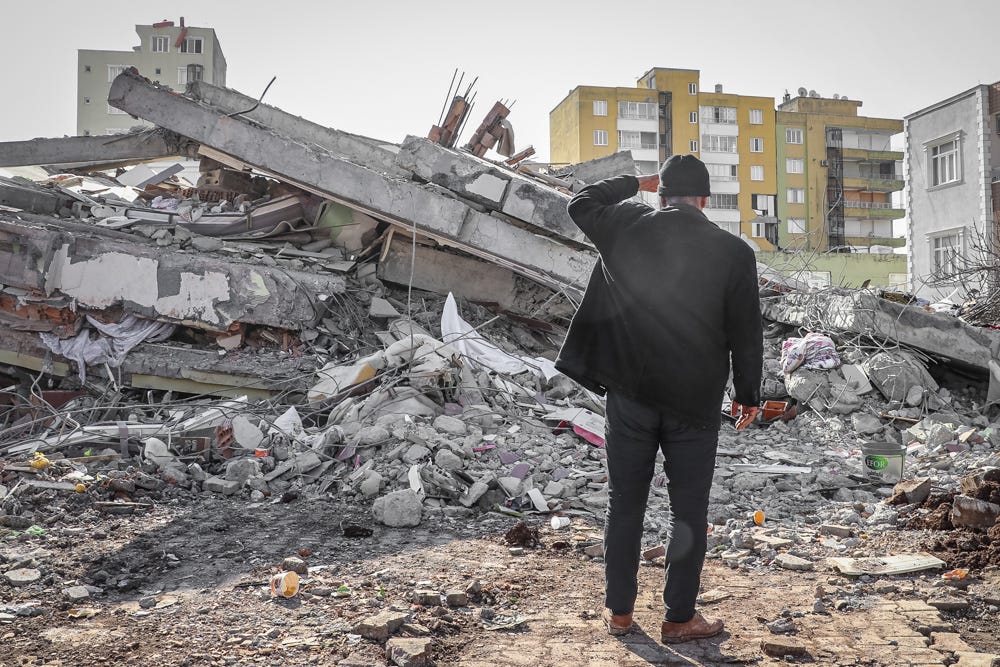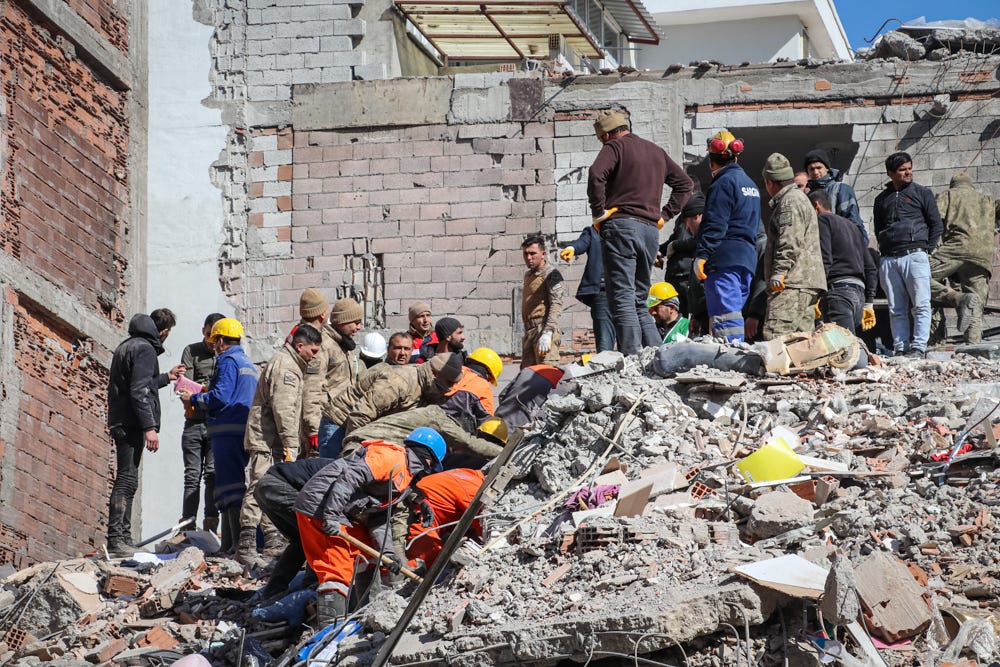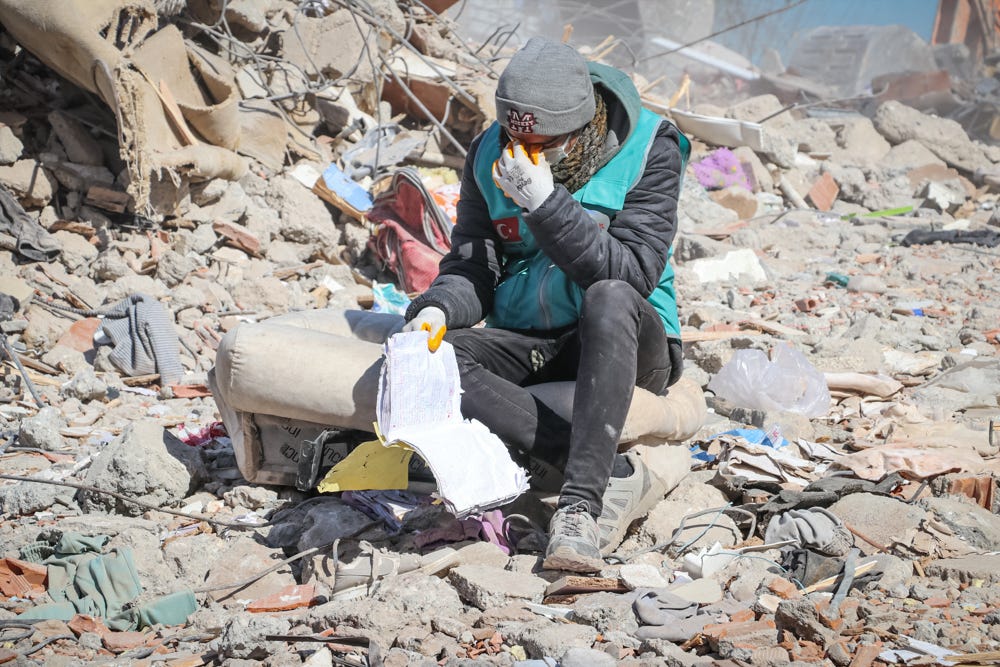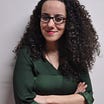In the center of Adıyaman, at the corner of Zey Road and Atatürk Boulevard, a woman waited by a collapsed building and said: "They came too late. We heard sounds (from inside) for three days, but now the sounds have stopped."
The woman, who declined to share her name, said her sister, nephew and brother-in-law remained under a separate collapsed building.
She expressed anger towards both the state and the media. She was one of many Adıyaman residents interviewed by Turkey recap who felt emergency response efforts remained inadequate and that press coverage also came late, failing to relay the true devastation of the city, and in turn, further delaying much-needed aid.
With a population of over 600,000, Adıyaman is among Turkey’s 10 most-damaged cities following the twin earthquakes on Feb. 6, but many residents feel they have been overlooked when they observe response efforts in the region’s other cities. The lack of aid, they said, led to many preventable deaths.
Left to the wolves
“There is no electricity, no phone, no internet,” said Kader, an earthquake survivor. “We couldn't make our voices heard. We tried to pull people out of the rubble until our hands were torn, but it didn't work.”
Kader continued, “If the televisions had shown and heard us, we could have saved everyone. The response was late. They left us to die.”
Another survivor, waiting for her family to be removed from the rubble of an eight-story apartment on Atatürk Boulevard, spoke in anger.
“We made the AKP the leading party in this city, but today no one even cares if we are alive or not,” she said, withholding her name. “Today, there is not a single official here. Adıyaman was left alone and without anyone to care for it. Those who turned a blind eye to our death today should not come tomorrow and ask us for votes.”
By Friday, the smell of corpses took over the city. As the number of bodies pulled from the rubble rises, the number of those found alive declines.
The bodies are kept on roads and sidewalks. Then they are brought to the hospital morgue with civilian vehicles and trucks. In the Çelikhan and Sincik districts of Adıyaman, earthquake survivors called coordinating officials to say some corpses were eaten by wolves.
Triage at the hospital
Other bodies were kept at local hospitals. A doctor working in Adıyaman's state hospital said many of the building’s sections have been closed and turned into morgues.
"There is no cooling system,” the doctor, who also requested to remain unnamed, told Turkey recap. “We keep the windows open so that the bodies don't smell. The bodies don't smell because it's cold."
Regardless, the sharp smell of decaying bodies is present the moment you enter the street where the hospital is located. The entrance of the hospital has been turned into an infirmary. Some survivors and their relatives, took shelter in the hospital, as well, since it was one of the city’s few places to have electricity in the first days after the earthquakes.
Most of the regular hospital staff is either trapped in collapsed buildings, lost relatives or are incapable of working because their relatives were still under the rubble. Doctors, nurses and health workers from other cities in Turkey have come to work instead.
The hospital building has some cracks and structural damage. Healthcare workers sleep on the floor and perform up to three surgeries at the same time in one operating room.
Rescue crews delayed
A group of 40 miners were the first to reach the city, but without the necessary digging equipment. Despite this, the team pulled 40 people out of the rubble alive in four days. They also recovered the lifeless bodies of 115 people.
Two days after the earthquake, the number of miners working in the city grew to about 1,000, which allowed the first batch of teams to rest.
One miner from Zonguldak compared the earthquake damage to past mining disasters in Soma and Zonguldak.
“We saw mines collapse, we had martyrs there, but we still did not see so much destruction, so much pain,” he said. “They sent us here late. If they had sent us sooner, we would have reached many more people alive.”
The biggest concern for many residents is recovering their loved ones' bodies intact. This anxiety, combined with hope they may still be alive under the rubble, results in families preventing the use of excavators.
Mert’s cat
At the search and rescue operation of two collapsed buildings in the Turgut Reis neighborhood, crews recovered a cat from the rubble.
Mehmet Hanifi Dayar, who was waiting for his 17-year-old son, Mert Dayar, to be pulled from the debris, said the cat belonged to his son. Despite repeated attempts to remove the cat from the area, the feline kept returning down into the debris.
“We call the cat, but it doesn’t come out. He goes back in the rubble to my son,” Hanifi Dayar said on Feb. 9. “Maybe he's alive, maybe that's why he doesn't leave him.”
The next day, Mert's lifeless body was found and removed. When crews pulled Mert out, along with five other people, the cat finally came out of the rubble and stayed out.
Coordination challenges
Due to the lack of coordination from official institutions in the city, opposition parties such as the CHP and HDP, together with their provincial and district organizations, and non-governmental organizations from surrounding cities, have attempted to establish coordination centers and distribute aid.
However, the arrival of aid, such as food and clothing, has put coordinators in a difficult position.
They have to throw away some bread loaves because they are too dry. They have to sort out torn and old clothes for hours. Much of the aid is simply dumped onto streets for survivors to rummage through.
Those working in coordination centers say the city’s most urgent needs are tents, heating devices, mobile toilets and hygiene products.
The lack of toilets is among the most challenging and most dangerous issues in the near-term, as infections can spread among the displaced population, which remains without adequate hygienic conditions.
Turkey recap is an independent platform supported by readers via Patreon and Substack. Members get access to our Slack, news tracking tools, calendar and more.
We also invite you to visit our merch store, but if you simply liked what you read, subscribe here or forward it to a friend. Feedback and pitches: info@turkeyrecap.com.
Diego Cupolo, co-founder + editor @diegocupolo
Gonca Tokyol, freelance journalist @goncatokyol
Ingrid Woudwijk, freelance journalist @deingrid
Verda Uyar, freelance journalist @verdauyar
Gökalp Badak, editorial intern @gklpbdk






